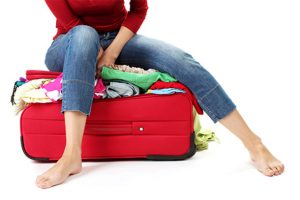You know those carry-on bag "sizers" strewn around airport ticketing and check-in areas? The ones that say "If your bag doesn't fit in here, check it"? The ones routinely ignored by both flyers and airline personnel?
If the International Air Transport Association has its way, they could be about to be replaced by even less capacious sizers.
IATA, which "represents some 260 airlines comprising 83% of global air traffic," on Tuesday proposed a new standard maximum size for carry-on bags.
Working with airline members of IATA and aircraft manufacturers, an optimum size guideline for carry-on bags has been agreed that will make the best use of cabin storage space. A size of 55 x 35 x 20 cm (or 21.5 x 13.5 x 7.5 inches) means that theoretically everyone should have a chance to store their carry-on bags on board aircraft of 120 seats or larger.
Bags that adhere to the new specification would be allowed to display an "IATA Cabin OK" sticker.
For context, the standard in place at American, Delta, and United—and hence the de facto industry standard in the U.S.—is 22 x 14 x 9 inches. Which raises the question: Could shaving just a half inch off of most dimensions really make a significant dent in the problem of overstuffed overhead bins?
IATA didn't share the calculations underlying the revised spec's alleged impact on bag stowage, and without more compelling proof, the proposal certainly warrants skepticism on the part of both airlines and travelers.
Indeed, it remains to be seen whether the new standard will be widely adopted. According to IATA, "A number of major international airlines have signaled their interest to join the initiative and will soon be introducing the guidelines into their operations." The Washington Post reports that eight carriers have committed to the new guideline: Air China, Avianca, Azul, Cathay Pacific, China Southern, Emirates, Lufthansa, and Qatar. So far, Air Canada is alone in publicly declining to follow IATA's recommendation.
If the proposal does gain traction, the winners and losers are clear to see. The airlines stand to reap even more in checked-bag fees, which amounted to $3.5 billion in 2014 for U.S. carriers alone. And bag manufacturers will enjoy a sales windfall, as travelers are forced to replace their newly out-of-spec bags.
The only bright spot for consumers: deep discounts on bags that no longer adhere to the airlines' new standard. But any up-front savings could be offset by fees to check those cheap bags when flying on airlines that adhere to the IATA guideline.
For now, travelers considering the purchase of new carry-on bags should hold off until there's more clarity regarding size restrictions.
You Might Also Like:
- 7 Ways to Make a Cheap Trip Feel Luxurious
- 9 Surprising Passport Facts You Need to Know
- 6 Insanely Cheap Summer Destinations
Read the original story: Airlines to Shrink Carry-on Size? by Tim Winship, who is a regular contributor to SmarterTravel.






